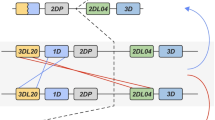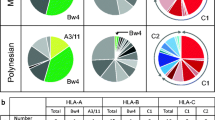Abstract
The interaction of killer-cell immunoglobulin-like receptors (KIR) and their respective major histocompatibility complex (MHC) ligands can alter the activation state of the natural killer (NK) cell. In both humans and rhesus macaques, particular types of non-classical MHC class I molecules are predominantly expressed on the trophoblast. In humans, human leukocyte antigen G has been demonstrated to act as a ligand for KIR2DL4, present on all NK cells, whereas Mamu-AG may execute a similar function in rhesus macaques. During primate evolution, orthologues of KIR2DL4 appear to have been highly conserved, suggesting strong purifying selection. A cohort of 112 related and unrelated rhesus macaques of mostly Indian origin were selected to study their KIR2DL4 genes for the occurrence of polymorphism. Comparison of the proximal region provided evidence for strong conservative selection acting on the exons encoding the Ig domains. As is found in humans, in the Indian rhesus macaque population, two different KIR2DL4 entities are encountered, which differ for their intra-cellular signalling motifs. One genotype contains a complex mutation in the distal region of exon 9, which negates a serine/threonine kinase site. Furthermore, both allelic entities are present in a distribution, which suggests that balancing selection is operating on these two distinct forms of KIR2DL4.





Similar content being viewed by others
References
Bimber BN, Moreland AJ, Wiseman RW, Hughes AL, O’Connor DH (2008) Complete characterization of killer Ig-like receptor (KIR) haplotypes in Mauritian cynomolgus macaques: novel insights into nonhuman primate KIR gene content and organization. J Immunol 181:6301–6308
Blokhuis JH, Doxiadis GG, Bontrop RE (2009) A splice site mutation converts an inhibitory killer cell Ig-like receptor into an activating one. Mol Immunol 46:640–648. doi:10.1016/j.molimm.2008.08.270
Bontrop RE (2006) Comparative genetics of MHC polymorphisms in different primate species: duplications and deletions. Hum Immunol 67:388–397. doi:10.1016/j.humimm.2006.03.007
Bontrop RE, Otting N, de Groot NG, Doxiadis GG (1999) Major histocompatibility complex class II polymorphisms in primates. Immunol Rev 167:339–350. doi:10.1111/j.1600-065X.1999.tb01403.x
Boyington JC, Brooks AG, Sun PD (2001) Structure of killer cell immunoglobulin-like receptors and their recognition of the class I MHC molecules. Immunol Rev 181:66–78. doi:10.1034/j.1600-065X.2001.1810105.x
Boyson JE, Iwanaga KK, Golos TG, Watkins DI (1996a) Identification of the rhesus monkey HLA-G ortholog. Mamu-G is a pseudogene. J Immunol 157:5428–5437
Boyson JE, Shufflebotham C, Cadavid LF, Urvater JA, Knapp LA, Hughes AL et al (1996b) The MHC class I genes of the rhesus monkey. Different evolutionary histories of MHC class I and II genes in primates. J Immunol 156:4656–4665
Boyson JE, Iwanaga KK, Golos TG, Watkins DI (1997) Identification of a novel MHC class I gene, Mamu-AG, expressed in the placenta of a primate with an inactivated G locus. J Immunol 159:3311–3321
Daza-Vamenta R, Glusman G, Rowen L, Guthrie B, Geraghty DE (2004) Genetic divergence of the rhesus macaque major histocompatibility complex. Genome Res 14:1501–1515. doi:10.1101/gr.2134504
de Groot N, Doxiadis GG, de Vos-Rouweler AJ, de Groot NG, Verschoor EJ, Bontrop RE (2008) Comparative genetics of a highly divergent DRB microsatellite in different macaque species. Immunogenetics 60:737–748. doi:10.1007/s00251-008-0333-z
Doxiadis GG, Otting N, de Groot NG, de Groot N, Rouweler AJ, Noort R et al (2003) Evolutionary stability of MHC class II haplotypes in diverse rhesus macaque populations. Immunogenetics 55:540–551. doi:10.1007/s00251-003-0590-9
Doxiadis GG, Rouweler AJ, de Groot NG, Louwerse A, Otting N, Verschoor EJ et al (2006) Extensive sharing of MHC class II alleles between rhesus and cynomolgus macaques. Immunogenetics 58:259–268. doi:10.1007/s00251-006-0083-8
Doxiadis GG, de Groot N, Claas FH, Doxiadis II, van Rood JJ, Bontrop RE (2007) A highly divergent microsatellite facilitating fast and accurate DRB haplotyping in humans and rhesus macaques. Proc Natl Acad Sci USA 104:8907–8912. doi:10.1073/pnas.0702964104
Doxiadis GG, Heijmans CM, Bonhomme M, Otting N, Crouau-Roy B, Bontrop RE (2009) Compound evolutionary history of the rhesus macaque MHC class I B region revealed by microsatellite analysis and localization of retroviral sequences. PLoS ONE 4:e4287. doi:10.1371/journal.pone.0004287
Du Z, Sharma SK, Spellman S, Reed EF, Rajalingam R (2008) KIR2DL5 alleles mark certain combination of activating KIR genes. Genes Immun 9:470–480. doi:10.1038/gene.2008.39
Faure M, Long EO (2002) KIR2DL4 (CD158d), an NK cell-activating receptor with inhibitory potential. J Immunol 168:6208–6214
Gedil MA, Steiner NK, Hurley CK (2005) Genomic characterization of KIR2DL4 in families and unrelated individuals reveals extensive diversity in exon and intron sequences including a common frameshift variation occurring in several alleles. Tissue Antigens 65:402–418. doi:10.1111/j.1399-0039.2005.00380.x
Goodridge JP, Lathbury LJ, Steiner NK, Shulse CN, Pullikotil P, Seidah NG et al (2007) Three common alleles of KIR2DL4 (CD158d) encode constitutively expressed, inducible and secreted receptors in NK cells. Eur J Immunol 37:199–211. doi:10.1002/eji.200636316
Grendell RL, Hughes AL, Golos TG (2001) Cloning of rhesus monkey killer-cell Ig-like receptors (KIRs) from early pregnancy decidua. Tissue Antigens 58:329–334. doi:10.1034/j.1399-0039.2001.580507.x
Guethlein LA, Flodin LR, Adams EJ, Parham P (2002) NK cell receptors of the orangutan (Pongo pygmaeus): a pivotal species for tracking the coevolution of killer cell Ig-like receptors with MHC-C. J Immunol 169:220–229
Hershberger KL, Shyam R, Miura A, Letvin NL (2001) Diversity of the killer cell Ig-like receptors of rhesus monkeys. J Immunol 166:4380–4390
Kaizu M, Borchardt GJ, Glidden CE, Fisk DL, Loffredo JT, Watkins DI et al (2007) Molecular typing of major histocompatibility complex class I alleles in the Indian rhesus macaque which restrict SIV CD8+ T cell epitopes. Immunogenetics 59:693–703. doi:10.1007/s00251-007-0233-7
Karl JA, Wiseman RW, Campbell KJ, Blasky AJ, Hughes AL, Ferguson B et al (2008) Identification of MHC class I sequences in Chinese-origin rhesus macaques. Immunogenetics 60:37–46. doi:10.1007/s00251-007-0267-x
Khakoo SI, Rajalingam R, Shum BP, Weidenbach K, Flodin L, Muir DG et al (2000) Rapid evolution of NK cell receptor systems demonstrated by comparison of chimpanzees and humans. Immunity 12:687–698. doi:10.1016/S1074-7613(00)80219-8
Kikuchi-Maki A, Catina TL, Campbell KS (2005) Cutting edge: KIR2DL4 transduces signals into human NK cells through association with the Fc receptor gamma protein. J Immunol 174:3859–3863
Korber B (2000) HIV signature and sequence variation analysis. In: Rodrigo AG, Learn GH (eds) Computational analysis of HIV molecular sequences. Kluwer, Dordrecht, pp 55–72
Marsh SG, Parham P, Dupont B, Geraghty DE, Trowsdale J, Middleton D et al (2003) Killer-cell immunoglobulin-like receptor (KIR) nomenclature report, 2002. Immunogenetics 55:220–226. doi:10.1007/s00251-003-0571-z
Marsh SG, Albert ED, Bodmer WF, Bontrop RE, Dupont B, Erlich HA et al (2005) Nomenclature for factors of the HLA system, 2004. Hum Immunol 66:571–636. doi:10.1016/j.humimm.2005.02.002
Martin AM, Freitas EM, Witt CS, Christiansen FT (2000) The genomic organization and evolution of the natural killer immunoglobulin-like receptor (KIR) gene cluster. Immunogenetics 51:268–280. doi:10.1007/s002510050620
Middleton D, Meenagh A, Gourraud PA (2007) KIR haplotype content at the allele level in 77 Northern Irish families. Immunogenetics 59:145–158. doi:10.1007/s00251-006-0181-7
Otting N, Heijmans CM, Noort RC, de Groot NG, Doxiadis GG, van Rood JJ et al (2005) Unparalleled complexity of the MHC class I region in rhesus macaques. Proc Natl Acad Sci USA 102:1626–1631. doi:10.1073/pnas.0409084102
Otting N, de Vos-Rouweler AJ, Heijmans CM, de Groot NG, Doxiadis GG, Bontrop RE (2007) MHC class I A region diversity and polymorphism in macaque species. Immunogenetics 59:367–375. doi:10.1007/s00251-007-0201-2
Otting N, Heijmans CM, van der Wiel M, de Groot NG, Doxiadis GG, Bontrop RE (2008) A snapshot of the Mamu-B genes and their allelic repertoire in rhesus macaques of Chinese origin. Immunogenetics 60:507–514. doi:10.1007/s00251-008-0311-5
Penedo MC, Bontrop RE, Heijmans CM, Otting N, Noort R, Rouweler AJ et al (2005) Microsatellite typing of the rhesus macaque MHC region. Immunogenetics 57:198–209. doi:10.1007/s00251-005-0787-1
Rajagopalan S, Long EO (1999) A human histocompatibility leukocyte antigen (HLA)-G-specific receptor expressed on all natural killer cells. J Exp Med 189:1093–1100. doi:10.1084/jem.189.7.1093
Rajagopalan S, Bryceson YT, Kuppusamy SP, Geraghty DE, van der Meer A, Joosten I et al (2006) Activation of NK cells by an endocytosed receptor for soluble HLA-G. PLoS Biol 4:e9. doi:10.1371/journal.pbio.0040009
Rajalingam R, Hong M, Adams EJ, Shum BP, Guethlein LA, Parham P (2001) Short KIR haplotypes in pygmy chimpanzee (Bonobo) resemble the conserved framework of diverse human KIR haplotypes. J Exp Med 193:135–146. doi:10.1084/jem.193.1.135
Rajalingam R, Parham P, Abi-Rached L (2004) Domain shuffling has been the main mechanism forming new hominoid killer cell Ig-like receptors. J Immunol 172:356–369
Sambrook JG, Bashirova A, Palmer S, Sims S, Trowsdale J, Abi-Rached L et al (2005) Single haplotype analysis demonstrates rapid evolution of the killer immunoglobulin-like receptor (KIR) loci in primates. Genome Res 15:25–35. doi:10.1101/gr.2381205
Schellekens J, Tilanus MG, Rozemuller EH (2008) The elucidation of KIR2DL4 gene polymorphism. Mol Immunol 45:1900–1906. doi:10.1016/j.molimm.2007.10.038
Single RM, Martin MP, Meyer D, Gao X, Carrington M (2008) Methods for assessing gene content diversity of KIR with examples from a global set of populations. Immunogenetics 60:711–725. doi:10.1007/s00251-008-0331-1
Slierendregt BL, van Noort JT, Bakas RM, Otting N, Jonker M, Bontrop RE (1992) Evolutionary stability of transspecies major histocompatibility complex class II DRB lineages in humans and rhesus monkeys. Hum Immunol 35:29–39. doi:10.1016/0198-8859(92)90092-2
Stewart CA, Van Bergen J, Trowsdale J (2003) Different and divergent regulation of the KIR2DL4 and KIR3DL1 promoters. J Immunol 170:6073–6081
Valiante NM, Lienert K, Shilling HG, Smits BJ, Parham P (1997) Killer cell receptors: keeping pace with MHC class I evolution. Immunol Rev 155:155–164. doi:10.1111/j.1600-065X.1997.tb00948.x
Vilches C, Pando MJ, Parham P (2000) Genes encoding human killer-cell Ig-like receptors with D1 and D2 extracellular domains all contain untranslated pseudoexons encoding a third Ig-like domain. Immunogenetics 51:639–646. doi:10.1007/s002510000184
Watkins DI, Chen ZW, Hughes AL, Evans MG, Tedder TF, Letvin NL (1990) Evolution of the MHC class I genes of a New World primate from ancestral homologues of human non-classical genes. Nature 346:60–63. doi:10.1038/346060a0
Witt CS, Martin A, Christiansen FT (2000) Detection of KIR2DL4 alleles by sequencing and SSCP reveals a common allele with a shortened cytoplasmic tail. Tissue Antigens 56:248–257. doi:10.1034/j.1399-0039.2000.560307.x
Witt CS, Whiteway JM, Warren HS, Barden A, Rogers M, Martin A et al (2002) Alleles of the KIR2DL4 receptor and their lack of association with pre-eclampsia. Eur J Immunol 32:18–29. doi:10.1002/1521-4141(200201)32:1<18::AID-IMMU18>3.0.CO;2-7
Acknowledgements
The authors wish to thank Donna Devine for editing the manuscript, Natasja de Groot for critical reading, and Henk van Westbroek for preparing the figures.
Author information
Authors and Affiliations
Corresponding author
Electronic supplementary material
Below is the link to the electronic supplementary material.
Supplemental Fig. 1
Microscopy of HEK293 cells 2 days after transfection (magnification ×400). From left to right: bright-field picture, 4′,6-diamidino-2-phenylindole-stained fluorescent nucleus, YFP-fusion protein, merge of previous pictures. Cells were transfected with pcDNA6.2/C-YFP-GW/TOPO containing as an insert a Mamu-KIR2DL4*001 (2DL4.1), b Mamu-KIR2DL4*01501 (2DL4.2) and c control chloramphenicol acetyl transferase. Since transfection efficiencies differ, some cells do not show YFP fluoresence because they were not transfected (JPEG 1709 kb)
Rights and permissions
About this article
Cite this article
Blokhuis, J.H., van der Wiel, M.K., Doxiadis, G.G.M. et al. Evidence for balancing selection acting on KIR2DL4 genotypes in rhesus macaques of Indian origin. Immunogenetics 61, 503–512 (2009). https://doi.org/10.1007/s00251-009-0379-6
Received:
Accepted:
Published:
Issue Date:
DOI: https://doi.org/10.1007/s00251-009-0379-6




